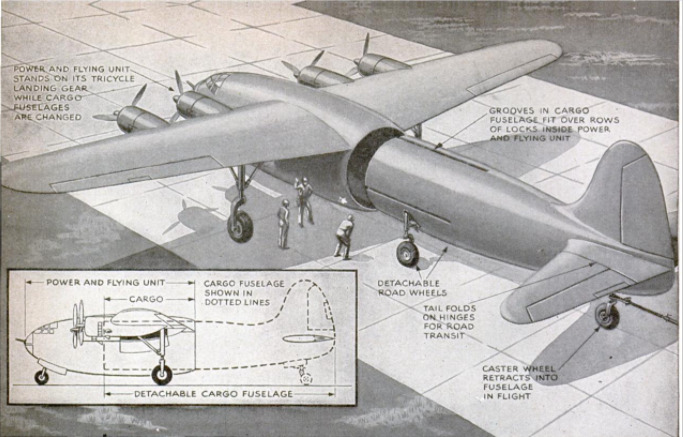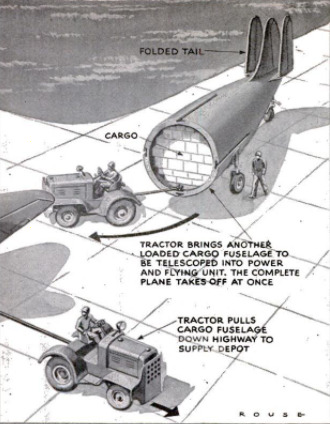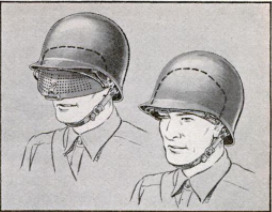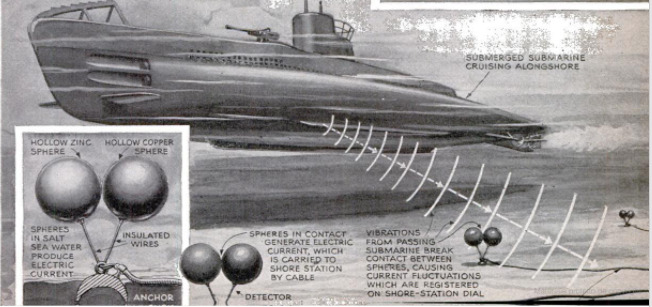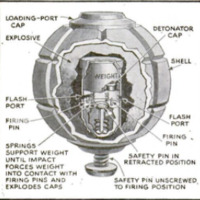War Ideas
Item
-
Title (Dublin Core)
-
War Ideas
-
Article Title and/or Image Caption (Dublin Core)
-
War Ideas
-
extracted text (Extract Text)
-
CARGO PLANES using the truck-trailer loading
principle are envisioned by Benjamin C.
Scheufele, of Philadelphia, Pa., as a means
of speeding up air freight transport. Instead
of having an urgently needed plane stand
idle while its cargo is unloaded ard outgoing
freight is stowed, he provides a detachable
fuselage section including the loading space
and tail assembly. On arrival at a terminal
airfield, this section is detached from the
unit containing the wings, motors, and con-
trol cabin. Dragged away to the supply de-
pot on removable road wheels and retract-
able caster tail wheel, it is replaced at once
by a similar section
already loaded with
outgoing cargo, and
the plane takes off
after a minimum turn-
around time. The cargo fuselage telescopes
inside the forward section to insure rigidity,
and to place the load in the necessary posi-
tion under the wings. Tail planes fold up-
ward for transit along roads to and from the
loading depot. By keeping the motive part
of the plane always busy, the inventor
points out, this plan would get more service
from available wings and power plants.
A HAND GRENADE that explodes on striking an
object has been devised by George Keeling,
of Ithaca, N. Y. Unlike earlier percussion
grenades which utilized a projecting pin to
detonate the explosive, the new missile em-
ploys a sliding weight containing the primer
charge. A threaded safety pin holds this
weight stationary until the grenade is armed
for use. When the pin is unscrewed and the
missile is thrown, springs hold the weight
out of contact with the firing pins. Upon
impact, inertia forces the weight against
the firing pins, which set off detonator caps.
Most grenades in use today are of the time-
firing type, in which an internal fuse is
ignited in throwing. These have the disad-
vantage that the fuse may give the enemy
time to take cover or even to throw the
grenade back.
VISORS FOR ARMY HELMETS are given practical
form by an invention of M. J. O. Lobelle, of
Langley, England. The idea, which pertains
chiefly to the method of hinging, provides a
protective shield made of thin, perforated
metal plate or a veil of chain mail. When
not in use, the visor is swung up inside the
steel shell of the helmet, as illustrated in the
drawing above, and does not interfere with
its normal comfort.
A SUBMARINE DETECTOR devised by the late Vladimir
S. Goloviznin, of New York City, employs electro- |
chemical action to give warning of enemy undersea
craft operating near the coast. Detector units, an-
chored in shallow water offshore, consist of pairs of
hollow spheres of dissimilar materials which gen-
erate an electric current when in contact in salt |
water. The vibrations produced in the water by a
passing submarine cause current fluctuations which
are recorded on instruments ashore.
-
Language (Dublin Core)
-
eng
-
Date Issued (Dublin Core)
-
1943-04
-
pages (Bibliographic Ontology)
-
56-57
-
Rights (Dublin Core)
-
Public Domain (Google Digitized)
-
Archived by (Dublin Core)
-
Matteo Ridolfi
-
Marco Bortolami (editor)
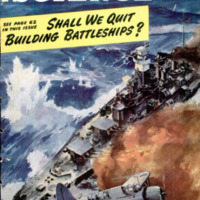 Popular Science Monthly, v. 142, n.4, 1943
Popular Science Monthly, v. 142, n.4, 1943

